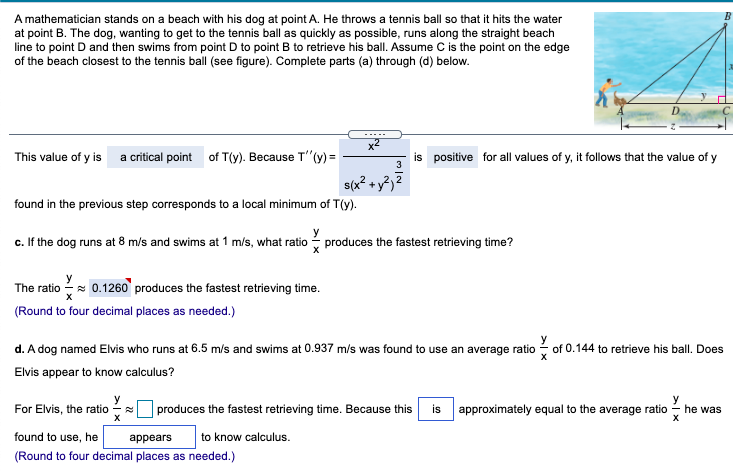A mathematician stands on a beach with his dog at point A. He throws a tennis ball so that it hits the water at point B. The dog, wanting to get to the tennis ball as quickly as possible, runs along the straight beach line to point D and then swims from point D to point B to retrieve his ball. Assume C is the point on the edge of the beach closest to the tennis ball (see figure). Complete parts (a) through (d) below. ---.. x2 This value of y is a critical point of T(y). Because T"(y) = is positive for all values of y, it follows that the value of y s(x? + y²)² found in the previous step corresponds to a local minimum of T(y). c. If the dog runs at 8 m/s and swims at 1 m/s, what ratio produces the fastest retrieving time? The ratio 2 0.1260 produces the fastest retrieving time. (Round to four decimal places as needed.) d. A dog named Elvis who runs at 6.5 m/s and swims at 0.937 m/s was found to use an average ratio of 0.144 to retrieve his ball. Does Elvis appear to know calculus? For Elvis, the ratio produces the fastest retrieving time. Because this is approximately equal to the average ratio he was found to use, he appears to know calculus. (Round to four decimal places as needed.)
Optimization
Optimization comes from the same root as "optimal". "Optimal" means the highest. When you do the optimization process, that is when you are "making it best" to maximize everything and to achieve optimal results, a set of parameters is the base for the selection of the best element for a given system.
Integration
Integration means to sum the things. In mathematics, it is the branch of Calculus which is used to find the area under the curve. The operation subtraction is the inverse of addition, division is the inverse of multiplication. In the same way, integration and differentiation are inverse operators. Differential equations give a relation between a function and its derivative.
Application of Integration
In mathematics, the process of integration is used to compute complex area related problems. With the application of integration, solving area related problems, whether they are a curve, or a curve between lines, can be done easily.
Volume
In mathematics, we describe the term volume as a quantity that can express the total space that an object occupies at any point in time. Usually, volumes can only be calculated for 3-dimensional objects. By 3-dimensional or 3D objects, we mean objects that have length, breadth, and height (or depth).
Area
Area refers to the amount of space a figure encloses and the number of square units that cover a shape. It is two-dimensional and is measured in square units.
I need help on the last part. Please fix sentence. "For Elvis, the ratio yx≈____ ?? produces the fastest retrieving time. Because this is or is not approximately equal to the average ratio yx he was found to use, he appears or dissappears to know calculus.

Trending now
This is a popular solution!
Step by step
Solved in 2 steps with 2 images


